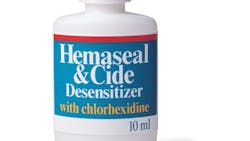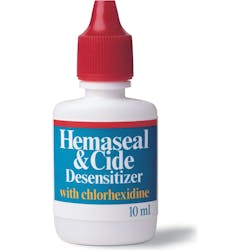Pearls for your Practice: Hemaseal & Cide by Advantage Dental Products
Post-op sensitivity is a real downer. I hate seeing postop sensitivity visits on my schedule. My team knows not to put them at the beginning of the day. We don’t want to start the day off on a bad foot. They know not to put them right after lunch. I don’t want to start my afternoon that way, either. In all honesty, it doesn’t matter where they go, they are a problem. They make me feel like a bad dentist. They can make the patient question the care they received. If I could only find a way to cut down on postop sensitivity. Good thing Hemaseal & Cide can do just that!
Hemaseal & Cide (Advantage Dental Products) is solution of 4% chlorhexidine applied after etching during your bonding process. Directions are fairly specific on application and drying, so be sure to follow them. After etching, apply a drop or two of Hemaseal & Cide to the preparation with a microbrush. Scrub the Hemaseal & Cide in the dentin for 10 to 15 seconds. Suction away the excess, then blot the rest of the excess with a dry microbrush. You want to leave the dentin lightly wet with Hemaseal & Cide, but not soaking. Hemaseal & Cide should be stored under 77 degrees but not refrigerated. If using with a self-etch product, place the Hemaseal & Cide before the bonding agent.
Another advantage to Hemaseal & Cide is an improved bond strength. Hemaseal & Cide penetrates the collagen matrix and keeps it puffed up. This leads to an increase in bond strength that has been noted in many different studies over the years.1,2 In addition to strengthening the bond, Hemaseal & Cide helps to turn off the matrix metalloproteinases that can break down dentin bonds over time. This will lead to better bonds over time!
In addition, Hemaseal and Cide helps to reduce microleakage in bonded restorations. Less microleakage means longer team bonds and restorations. Finally, Hemaseal & Cide is a great antimicrobial under restorations. When we can fully disinfect teeth before bonding to them, we will get better bonds with fewer postop issues.
Adding Hemaseal & Cide to your restorative dentistry workflows means adding about 20 seconds and basically two steps (applying and carefully drying). If this cuts down on one postop visit per month, it would pay for itself a few times over. Not only is Hemaseal & Cide great, it is also very reasonably priced, especially compared to the competition. Solo home run to left field for Advantage Dental!
References
- Li D, O’Keefe KL, Powers JM. Effect of dentin desensitizers on bond strength on deep dentin. J Dent Res. 2000;79(suppl A). Abstract 2928.
- Celik EU, Kumbaraci N, Cal E, Turkun M. Influence of two desensitizer agents on the microleakage of adhesively luted ceramic inlays. Eur J Dent. 2011;5(1):77–83.
Joshua Austin, DDS, MAGD, writes the Pearls for Your Practice column in Dental Economics. After graduating from the University of Texas Health Science Center Dental School, Dr. Austin associated for several years. In October of 2009, he opened a solo general practice in a suburban area of San Antonio, Texas. Dr. Austin is involved in all levels of organized dentistry and can be reached at [email protected].
About the Author
Joshua Austin, DDS, MAGD
Joshua Austin, DDS, MAGD, is a graduate and former faculty member of the University of Texas Health Science Center at San Antonio School of Dentistry. Author of Dental Economics’ Pearls for Your Practice column, Dr. Austin lectures nationally on products, dental technology, online reputation management, and social media. He maintains a full-time restorative dentistry private practice in San Antonio, Texas. You may contact Dr. Austin at [email protected].
Updated June 21, 2023


